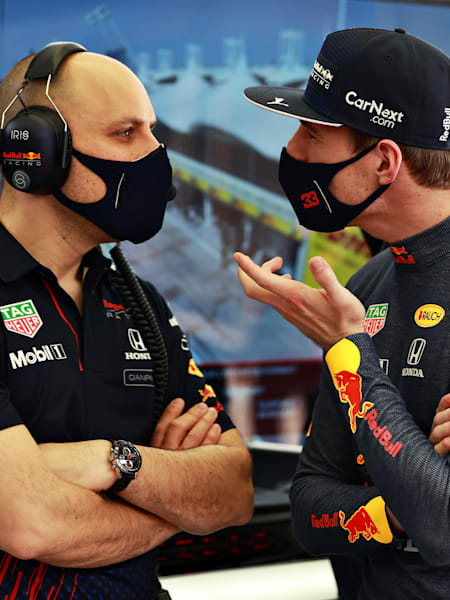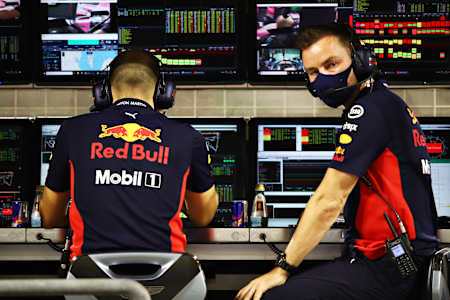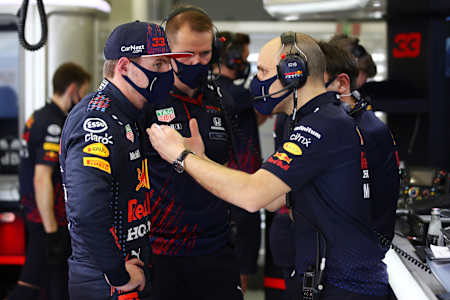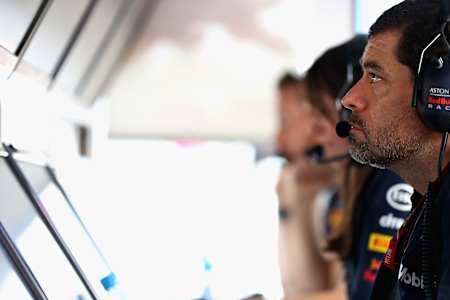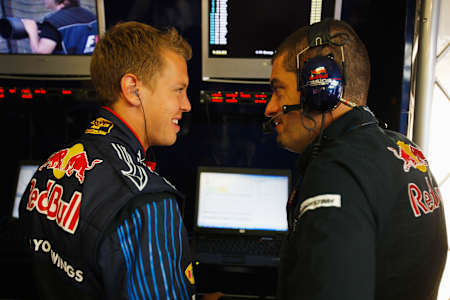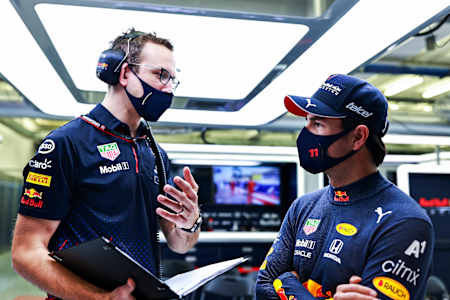20 years ago, there were fewer people from a Formula One team in the public eye. Drivers and the team principal, perhaps even a technical director – if it was a Ross Brawn or an Adrian Newey. Everybody else tended to be a shirt in the background, but this has changed.
Better access for broadcasters, online channels for the teams, streaming series and so forth have needed more people to look at and talk to. It’s not exactly been an overnight revolution, but in 2021, it’s fairly common for team managers, no.1 mechanics, strategists and race engineers to be recognisable – though for the latter it is sometimes more as a voice than a talking head.
The ubiquity of pits-to-car radio messages broadcast during a grand prix has made the soothing – usually – tones of the race engineer a familiar part of the race to spectators at home – but there’s a great deal more to the job than telling a driver to push, box or focus.
They are responsible for getting the performance out of the car and the driver, and the filter through which the team and driver communicate. They are responsible for set-up in the garage and the director of operations during the qualifying hour. Moreover, they tend to be the driver’s advisor, confidant and confessor. There’s a lot going on in a race engineer’s job description.
The Evolution Of Race Engineering
In every branch of professional motorsport, there is always someone responsible for the mechanical set-up of the car. In Formula One, the role of the race engineer has evolved over time. When F1 teams were tiny things, it would very much be a part-time occupation, which is why you would have people like Adrian doing the hard yards as a race engineer, or Frank Williams.
Gradually, as the sport grew, it turned into a full-time occupation, and then more than a full-time occupation. With the amount of data being generated from an F1 car, the job became too much for one person to handle, and thus it was split into constituent parts. Every team does it their own way, but the norm is to have a race engineer supported by a performance engineer.
Simon Rennie, our Group Leader of Simulation Engineering, spent many years as race engineer to Mark Webber, Daniel Ricciardo and most recently for Alex Albon. He came to Red Bull from a spell at Renault/Lotus where he worked with Fernando Alonso, Robert Kubica and Kimi Räikkönen. “The performance engineer is in control of the electronic settings on the car,” explains Simon.
“He looks after things like the differential settings, the way the brake balance is shaped, the electronic control systems and how they are mapped. There’s a lot of fine-tuning in those tasks. This leaves the race engineer free to be accountable for the physical set-up of the car: the wing levels, the ride-height, the roll bars and so on, plus looking after the tyres, the legality of the car and parts of the build process.”
It is common that a race engineer will have a stint as a performance engineer in their background and will often first take on the race engineer’s duties as a stand-in, or at a test. Hugh Bird, Checo’s race engineer, has taken over from Simon after being Max’s performance engineer last year.
The Tip of the Spear
While most teams still have their race engineers on the pit wall during a grand prix, for the rest of the weekend they’re usually to be found at a workstation adjacent to their car. The best place to see the driver and perhaps more importantly the no.1 mechanic. While everyone is speaking via the intercom, there’s huge value in non-verbal comms and seeing the car.
When the car is in the garage, it’s not unusual for both the performance engineer and the race engineer to be speaking to the driver. The race engineer will also be speaking to other members of that car’s team. In the garage, that might be mechanics or tyre/fuel/bodywork technicians, controls and systems engineer. It might also be strategists or engineers back in the Ops Room at the factory.
When the car is on track, barring something extraordinary, the race engineer will be the only one talking to the driver, but all of the other roles will be feeding information into them. They’ll pass along setting changes for the car and power unit to the driver, but much of the information is intended to help the race engineer have the fullest picture of the race, from which they can make informed decisions. How much of that they share with the driver varies from driver to driver, and sometimes day to day.
The Pursuit of Performance
Watch the progress of a particular car through the practice sessions of a grand prix weekend, more often than not you’ll see a steady decrease in lap time. Some of this is the track getting quicker as more rubber goes down, but much the larger part is the driver and his engineers fine-tuning the set-up. This is where the science and art of F1 collide, with the race engineer looking for the compromise between a theoretical optimum and a car that the driver is comfortable with.
Perhaps the biggest chunk of performance comes from driver confidence to brake late, ride kerbs and pushing the car to its limits. Although allowing them to do that often requires sacrificing a little bit of raw speed from the car and taking it off the absolute limit.
Two drivers might be feeling the same thing in the car – but they’ll talk about it in a different way, or use completely different language.
This, perhaps, is where the process gets difficult: it depends on feedback from the driver, but drivers are not robots. Their comments need to be quantified, but don’t tend to come in tidy, mathematical packages. Interpreting what they say – or sometimes what they don’t say – requires an insightful race engineer. Some of that insight can be derived from looking at data but it’s mostly a product of having a strong bond with the driver – thus a driver and his closest engineers tend to form an inner enclave within the larger team.
“Two drivers might be feeling the same thing in the car – but they’ll talk about it in a different way, or use completely different language,” says Simon. “It takes time to understand what they’re saying, translate that into engineering terminology we can all understand and work with – because it’s very possible initially they’ll be describing the driving experience using descriptive words only they understand. Comprehending what they’re really saying is half the battle. The other half is understanding what they need from the balance of the car to make them go as fast as possible.”
Guillaume Rocquelin – aka Rocky – our Head of Race Engineering is essentially the bridge between the race engineering teams on either side of the garage. He’s been with the team since 2006 and spend many years as race engineer to David Coulthard and Sebastian Vettel.
I was David’s race engineer when I first came to the team. He had massive experience, so I didn’t need to deal with much off-track.
“The task is the same but the approach is massively different,” he says. “I was David’s race engineer when I first came to the team. He had massive experience, so there were a lot of things that I didn’t need to deal with. Things like interactions with other drivers, the media, the FIA. David had 14 years in F1 so he knew it inside-out. He was very specific on what he wanted, in terms of setting up the driver interface. I wouldn’t call it a one-way conversation, but it was a job that revolved around ensuring he got what he wanted from the car.
“After David retired, Sebastian took over the seat, and that was a much more open-ended job. He was very young when he joined us, so there was a lot of things in F1 that were still new to him. Interaction with the media and the FIA etc. I had to step-up a bit and take more of a role, and give him some pointers, which was of course, never the case with David.”
Just The Facts…
The modern era, in which radio communications to the driver are a staple of the F1 broadcast, has revealed there’s more to the job that simply delivering dry information. That of course is present, but perhaps surprisingly is the race engineer’s ability to coax speed out of the driver by affecting his mood. Some drivers really do prefer to receive the facts as undemonstratively as possible and are more-than capable of inferring what has to be done – others, however, respond well to a bit of cheerleading.
The corollary, of course, is that the race engineer needs to know when imparting information is going to be counter productive. Telling the driver to drive faster can be demoralising when they’re already at the limit; informing them of penalties might not be something to share; suggesting a raft of settings changes when they’ve just settled in can destroy a rhythm. It’s a fine balance that has to be achieved.
The Odd Couple
Part of the fascination in the relationship between driver and engineer is the evident clash of personalities. Many pairings will vehemently deny this and claim they’re both exceptionally competitive and always on the same page. However, to the outside world the portrayal tends to be that of a driver screaming into the radio. This needs to be answered calmly, ignoring the tone and replying with a dry message to stay focussed; keep doing what you’re doing, or perhaps move the brake balance forwards a click.
The majority of the time, the process works well – but F1 thrives on drama and the elements of the driver–engineer relationship that sell this drama tends to be the critical situations – often characterised by an engineer on the receiving end of a waspish comment from a driver. It isn’t, however, entirely a fair reflection of the tone of conversation over the weekend as a whole.
“It’s really just the feed picking up the bits they want,” offers Rocky, who had more than his fair share of broadcast minutes for continually pointing out to Vettel that there were not more points on offer for lapping the entire field. Simon Rennie’s experiences, on the other hand, are perhaps even more famous, having launched a thousand memes when engineering Kimi Räikkönen at Lotus in 2012. Did Räikkönen really know what he was doing? “Yes,” says Rennie with a broad grin. “…but he could have been doing it a bit more.”
